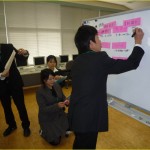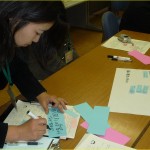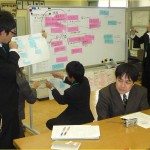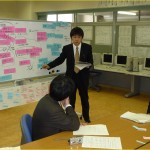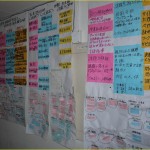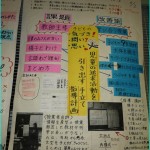Pete Dudley 2012
Tomoko Tamura WSLS Click to download presentation.
lessonstudy.co.uk is very grateful indeed to the generosity of Japanese researcher Tomoko Tamura for sharing her case study with us and allowing publication of key aspects on this website. We are also grateful to Onta Primary School in Tokyo for granting us permission to publish this information on the web.
Tomoko’s work interests me because it shows how Lesson Study can radically improve educational outcomes in very poorly performing schools and transform them into sustained, self-improving very successful schools.
Most of the work involving Lesson Study that was funded by the National Strategies in England under my leadership between 2007 and 2011 was undertaken with schools that were not the most poorly performing but rather just ‘coasting’. In these schools learning, teaching and leadership tended to be satisfactory rather than inadequate. ‘Leading Teacher’ coaches who were successful class teachers in nearby schools trained in LS techniques would work with teachers in those schools which triggered the funding. They would work with year six teachers to identify children who’s prior attainment predicted that they should have made more progress than they had managed to do in their time in KS2. They conducted one Lesson Study cycle with the Y6 teachers in which three or four of these pupils were the case pupils. They would often use NS materials designed to improve progress in English and mathematics such as Talk for Writing, Support for Writing and the Securing Levels in mathematics publications now available at (teachfind.com). The year six teachers were funded to then lead a lesson study with their own year 5 teachers in the second half of the summer term. Most years the increase in KS2 results in these schools was around double that seen nationally and the cost of the support per school was around £850.
However, I became increasingly aware of cases where schools that has been consistently below the national floor targets or which had been placed in special measures by Ofsted were using LS and were getting plaudits from HMI or Local Authority staff for the impact of LS on teaching, learning and standards. Indeed one local authority, Bradford, used LS in its lowest performing schools and the dramatic impact is reported in Hadfield et al 2011. (See ‘Quick Win Lesson Study in the lessonstudy.co.uk news archive).
Tomoko Tamura’s case study documents a similar case in Tokyo and shows the value in recording and making public the outcomes of the post lesson discussions and the lessons that evolved and that worked.
Workshop Style Lesson Study (WSLS)
Tomoko Tamura and Hiroyuki Kuno are two Japanese teacher educators and researchers who have helped to lead the development of WSLS.
Tomoko has studied Onta elementary school. This school achieved the lowest educational outcomes in Tokyo in annual Grade 6 (Year 7) assessments in Japanese and Mathematics almost every year until 2004 when a new head reformed the school. His strategy was to improve the quality of learning and teaching in lessons and the method he adopted was a new form of Japanese Lesson study called ‘Workshop Style Lesson Study’ (WSLS).
Lesson Study (LS) has been practiced in Japan for at least 140 years. Most Japanese teachers will be members of at least one LS group at any point in their career. However, standard LS practice has been seen by some to have evolved into a rather ceremonial practice (Tamura, 2011) which limits the opportunities for collaboration, risk-taking and innovation of new teacher practice knowledge that is seen in more action research and enquiry informed approaches developed in the UK and Singapore (Dudley, 2012).
The effects on the quality of teaching and pupil progress at Onta were dramatic. Teachers used WSLS to unpick their teaching and to observe and overcome the obstacles to pupil learning through the detailed joint planning of research lessons, the close observation and joint discursive analysis of the learning as well as the barriers to learning they had witnessed. Onta has introduced much more interactive learning and problem solving into their pedagogical repertoire through the LS engendered approach.
Onta now has outcomes in Japanese and Mathematics that are well above the Tokyo and Japan averages.
Post Lesson Discussion and creation of new, improved lessons
The post research lesson discussions at Onta are very dynamic and active events. Teachers work in pairs and threes and use pink post-its to record observations that focus on obstacles, difficulties and which are more critical than positive. (Remember – because everyone plans and owns the research lesson the whole group owns the successes and the learning points. No one is left exposed). Large post-its are used to write detailed observations, hypotheses and questions. The ‘chairperson’ takes a leading role in helping the participants to group the observations together into related themes giving the themes names.
The pairs then discuss potential improvement strategies and note each on a blue post-it. Again these are analysed by the group. The teacher who taught the research lesson then makes a revised plan (using yellow post-its) incorporating the group’s ideas. This becomes the next research lesson in the LS.
Displaying the revised research lessons
The groups make posters based upon the research lesson plans and illustrated and brought to life with examples of teaching materials, pupils work, quotes from pupils and photographs. These posters are displayed in corridors leading to the staffroom and in the staffroom itself at Onta elementary school. The display of teachers’ work in this way mirrors the way teachers make displays of pupils work so that the outcomes are given public value but also so that others can learn from them.
Let’s not forget the value placed on making practice public in the second McKinsey report on how the world’s most improving school systems keep getting better (Barber et al 2010).
- The representatives of the groups make critical comments about the lesson and make larger labels on which they have written their opinions.
- After this critical discussion, they discuss in small groups again.
- The representatives of the groups offer ideas on how the research lesson can be improved.
- After discussion, the teacher who did the research lesson comments on the ideas that other teachers suggested.
- The teachers of this school have such lesson studies once a week; thus, there are many charts on the corridor walls.
- The blueprints of revised lesson plans

